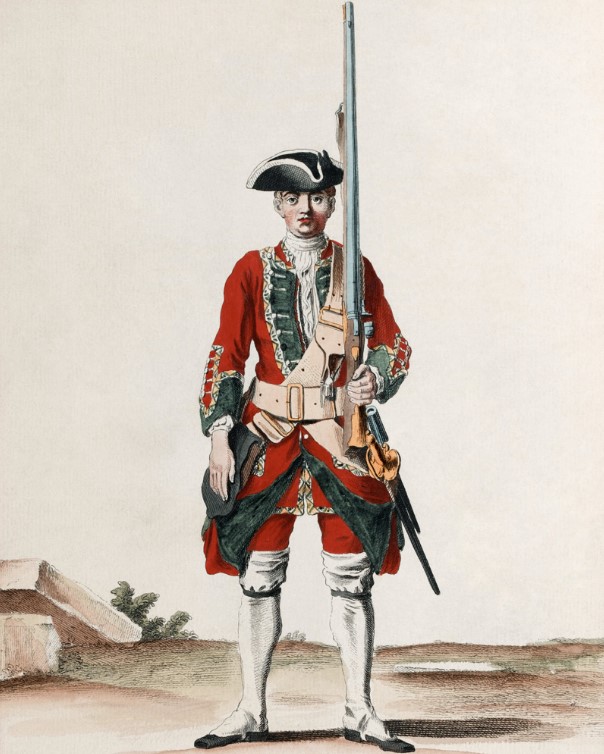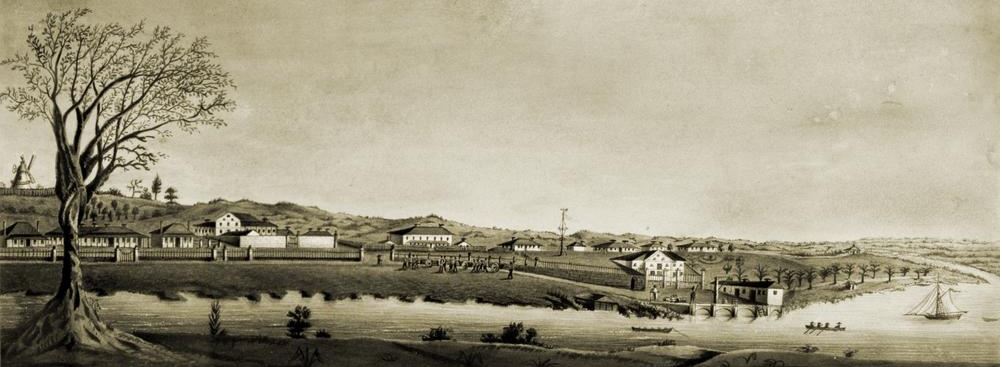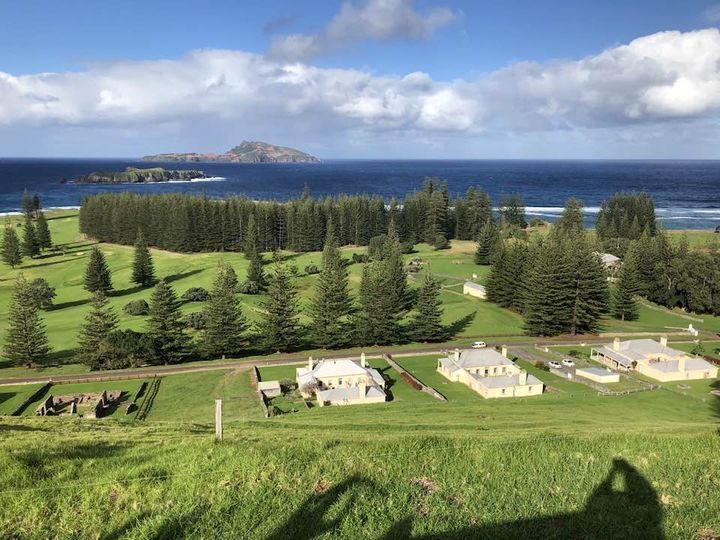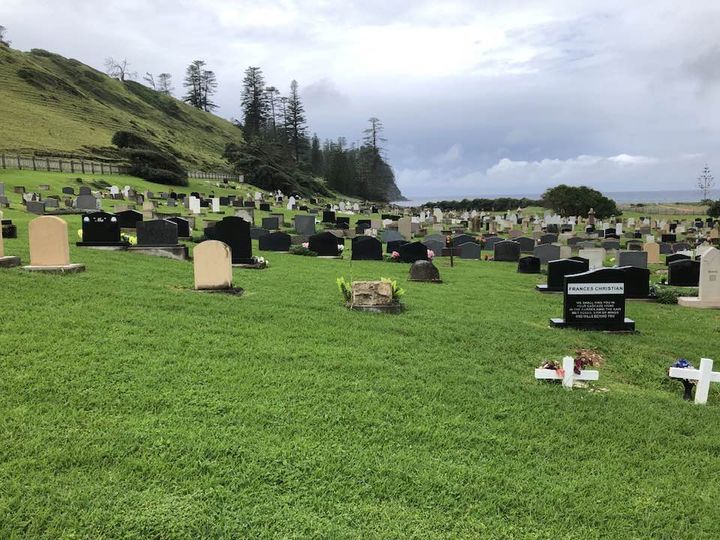George John Arnold Mackenzie Cameron (ca. 1826 – 1865), British soldier, was born in Dingwell, Scotland. He arrived at Hobart Town aboard the Sir Robert Peel in December 1846 along with 47 soldiers of the 11th Regiment. His first posting was to Norfolk Island in April 1848 and then to Moreton Bay, arriving on the Tamar on 7 November 1848. He remained at Moreton Bay until July 1850, when he was posted south for guard duty on Cockatoo Island from 1850 to 1851. While at Cookatoo Island, Cameron transferred from the 11th Regiment to the 7th Fusiliers. Then in the same week, he transferred from the 7th Fusiliers to the 10th Regiment. After marrying Mary Stobo in Sydney in May 1852, Cameron returned to Brisbane Town and retired from the military. In July 1858 he married Maria Feeney at Ipswich. In March 1865 the Camerons boarded the Fiery Star for London but the ship caught fire east of New Zealand. They boarded one of the overcrowded life-boats but were never seen again.
George Cameron was born in 1826 in Dingwell, Scotland as one of seven children and raised by his widowed mother since his father, Captain John Mackenzie Cameron, died in South Africa in 1827. As Captain John Cameron had served in the 72nd, the 60th and finally the 55th Regiment, George’s mother was hopeful his application for an ensigncy in the 55th Regiment would be received favourably. While Cameron was made an ensign in the 55th Regiment without purchase on 23 February 1844, he transferred the following year into the 11th Regiment on 26 February 1845. As most of the elements of the 11th Regiment had already sailed for the Australian Colonies, George was attached to the Regiment’s depot company until 1846, when a final convict ship departed Chatham for Van Diemen’s Land. He arrived at Hobart Town aboard the Sir Robert Peel in December 1846, along with forty-seven soldiers of the 11th Regiment, plus one wife and her child. His first posting was at Norfolk Island where he remained from April 1847 to September 1848 and then was sent to Moreton Bay from November 1848 to July 1850. He arrived at Brisbane aboard the Tamar on 7 November 1848 along with thirty-five soldiers of the 11th Regiment, seven women and eighteen children. Cameron’s period of service at Brisbane Town was eventful to say the least. His first duty in Brisbane was to provide a quarantine guard of six soldiers for the Fortitude, which had arrived with fever on board. Cameron then complained of a fact which effected every military detachment sent to Moreton Bay, the lack of cash with which to pay his detachment.
Late in the night of 28 November 1849, an incident happened which changed Cameron’s career. A brick-maker named Henry Humby, living around Victoria Park, feared that an Aboriginal uprising was immanent after being told an exaggerated tale by an Aboriginal boy named Wamgul. Humby rushed into Brisbane Town to inform a constable, but finding only an elderly night watchman named MacAlistair, he relayed to him Wamgul’s account of a massed Indigenous uprising. MacAlistair passed this story onto Constable Thomas Conroy, who in turn passed it on to the Chief Constable William Fitzpatrick. Fitzpatrick, who was bed-ridden with rheumatism, told Conroy to take another Constable and investigate, but clearly unwilling to do so, Conroy told the Brisbane detachment of the 11th Regiment instead. Sergeant Michael Clarke ordered the drums beat “to arms” and Cameron’s servant, Private James Tredennick, was dispatched to inform Cameron, who was fishing on the banks of the Brisbane River, of the situation. As Cameron had not been made a magistrate, unlike all his military predecessors, he sought out the nearest justice of the peace, Dr Keith Ballow, and requested his attendance and direction in what threatened to be a serious conflict. Ballow, however, refused to go with Cameron and merely gave him a verbal direction to take whatever steps he thought necessary to restore peace. As Cameron had no knowledge of a magistrate’s authority, he mistakenly felt he was powerless under law to act without their direction. Yet in this he was mistaken and the ongoing confusion between martial law and civil administration cost valuable time.
Cameron marched his small force of thirty soldiers to Victoria Park where a corroboree was taking place. He then ordered his force to fix bayonets and load with ball cartridge, before dividing his force in half to approach the Aboriginal camp from converging directions. While Cameron commanded the right “division”, Sergeant Michael Clarke commanded the left. It was Cameron planned to approach the camp and order it to be dispersed, however, a volley of musket shots thundered out from Clarke’s force, followed by a shot from his own. As a result of this unprovoked attack, three Aborigines were wounded, although only one agreed to submit himself for medical treatment, and this was Wamgul himself. In the ensuing investigation, Cameron was censured for not keeping a tighter control over his force, although the person singled out for most blame was Chief Constable William Fitzpatrick who became a scapegoat for a multitude of errors committed that night. Considering Wamgul’s mischievousness, Ballow’s indecision, Cameron’s inexperience and Conroy’s panic, it seemed strange Fitzpatrick should be singled out as the central cause of this collision.
Cameron remained in Brisbane until July 1850, when he was posted south for guard duty on Cockatoo Island. During his posting there over 1850 and 1851, Cameron transferred from the 11th Regiment to the 7th Fusiliers and then, in the same week, from the 7th Fusiliers to the 10th Regiment, before finally retiring from the army in February 1852. He then married Mary Stobo at the Scots Church, Sydney on 8 May 1852. Cameron’s interest in the army was not entirely over, however, as he and his new wife moved to Brisbane and he was elected 1st Lieutenant in the newly raised Queensland Volunteer Rifle Brigade.
In July 1858 he married Maria Feeney, widow of Martin Feeney, an 99th Regiment soldier and Governor of the Brisbane Gaol. Maria had inherited the Prince of Wales Hotel upon Martin Feeney’s death and together the Cameron’s owned and ran the hotel on the corner of Charlotte and Edward Streets. In March 1865 they boarded the Fiery Star for London, but the ship caught fire east of New Zealand at a point about 400 miles from the Chatham Islands group. On Good Friday, 14 April 1865, the few surviving witnesses recalled seeing the Camerons board one of the overcrowded lifeboats, but they were never seen again. George’s will revealed a remarkable oversight. He had married one Mary Jane Stobo, also known as Gillett, at Sydney in May 1852 and was still married to her when he married Maria in 1858, which resulted in litigation and not a little scandal.
Note: This biography is based on research by Rod Pratt, former Visiting Fellow with the Harry Gentle Resource Centre. Additional research was conducted by Dr Lee Butterworth.
Citation
Rod Pratt and Lee Butterworth, ‘George John Arnold Mackenzie Cameron (ca. 1826 – 1865)’, Harry Gentle Resource Centre, Griffith University, 2022, https://harrygentle.griffith.edu.au/life-stories/george-john-arnold-mackenzie-cameron/.
Archival Resources
SLQ, Colonial Secretary letters received relating to Moreton Bay and Queensland 1822-1860
A2 series microfilm, Reel 19, pp. 234-236, 24 January 1848.
NSWSA, Colonial Secretary Main series of letters received, 1826-1982
Item 4/2863.2, Cameron to Wynyard 18 May 1849.
Subseries (Pieces 2874-2890). 11th Foot, April 1845 – March 1858.
Qld BDM, marriage registration number: 1859/C/191
George John Arnold McKenzie Cameron to Maria Feeny, 29 Jul 1858.
NSW BDM, marriage registration number: 550/1852 V1852550 80
George John Arnold McKenzie Cameron to Mary Jane Caroline Stobo, 1852.
Journals
The Affray at York’s Hollow, November 1849. Rod Pratt, Royal Historical Society of Queensland Journal, Vol. 18, Issue 9, 2004, pp. 384-396.
Newspapers
Colonial Times and Tasmanian, Colonial Times, 22 December 1846, p. 2.
Departures, Sydney Chronicle, 2 June 1847, p. 2.
Investigation Respecting the Affray with the Aborigines, Sydney Morning Herald, 17 December 1849, p. 2.
Family Notices, Launceston Examiner, 29 May 1852, p. 3.
The Fiery Star, Empire, 1 July1865, p. 8.
Burning of the Fiery Star, Queensland Times, 30 May 1865, p. 3.
Supreme Court, The Brisbane Courier, 2 May 1879, p. 3.
Supreme Court, The Brisbane Courier, 2 July 1879, p. 6.
Supreme Court, The Brisbane Courier, 26 September 1879, p. 3.
Irish Famine Relief Committee, The Queenslander, 14 February 1880, p. 200.
Judicial Affairs, The Queenslander, 1 November 1879, p. 569.
Family Notices, The Courier, 25 September 1858, p. 2.
Online Resources
Colonial Secretary letters received relating to Moreton Bay and Queensland 1822-1860
Military - Colonial Secretary Main series of letters received, 1826-1982
Office of the Commander-in-Chief: Memoranda and Papers
Memoranda of appointments, promotions and resignations: 19 February 1844
NSW Births, Deaths and Marriages search
Colonial Secretary letters received relating to Moreton Bay and Queensland 1822-1860
State Library of Queensland - Newspapers
Cameron Genealogies: Lieut George John Arnolds [sic] McKenzie Cameron






